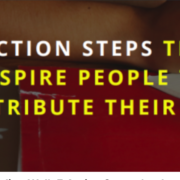Being for Real in a “Fake It Till You Make It” World: Elizabeth Holmes is a Perfect Example

Fake it till you make it seems innocent enough: if you show competence, confidence, and optimism, then your power of positive thinking will deliver the results you want.
Bulls–t said with conviction is still bulls–t. The fraud trial of disgraced Theranos founder Elizabeth Holmes tears the mask off of Silicon Valley’s “Fake it till you make it” mantra. A jury convicted Holmes of fraud over her bogus claims that Theranos’ blood-testing could detect a wide variety of illnesses.
It was a story everyone wanted to believe. A 19-year old Stanford dropout with a breakthrough idea ready to shatter Silicon Valley’s douchebaggerous bro culture. Her charisma fooled even the likes of former U.S. Defense Secretary General James Mattis into coughing up investment money until “I didn’t know what to believe about Theranos anymore.” Even the most seasoned decision-makers believe what they want to until disaster tears the veil from the eyes.
Fake it till you make it seems innocent enough: if you show competence, confidence, and optimism, then your power of positive thinking will deliver the results you want. Law of Attraction enthusiast Rhonda Byrne counsels’ people to make-believe. As you make-believe, she tells us, you will begin to believe that you have received.
It’s total claptrap.
I’m all about the importance of positive self-talk, along the lines that Dan Gilbert suggests in Stumbling on Happiness. You’ve got to believe in your ability to succeed and encourage yourself to take action. You get good results when you take wise steps, which reinforce your positive beliefs. It’s a virtuous cycle.
Authenticity is the difference between positive self-talk and fake-it-till-you-make-it charlatanism. Charlatans have conviction — charisma taken to an unhealthy extreme. Authentic people are humble: they recognize that others have value and that you can learn from them. They have a healthy degree of imposter syndrome.
Be for real, get the deal, is the antidote to charlatanism. Look for humility in business leaders, politicians, pundits, and others who want your support. Always get the other side of the story.
Attune your b.s. meter to those who speak with absolute conviction; run, don’t walk away.
Here’s my 2022 reading list for leaders and consultants.
My mission is to help successful people like you gain new heights by being the best version of yourself and inspiring people to contribute their best and most authentic selves to your team’s success.
Consulting Mastery is my 8-week mastery program for consultants and experts who want to build a meaningful, joyful, and profitable business and take it to new heights. This program, a variant of FOCUSED, orients exclusively on consultants and experts. I’ll run this program twice in 2022. We meet once per week for 90 minutes via zoom. The program begins in late January; only eight spaces are available. Your investment is $4500 by January 15; then, the fee rises to $5500. Most participants say that the program pays for itself in the first two weeks. Click here for more information and to apply.
Consulting Masterclass. In this interactive, 90-minute masterclass on January 13, you will gain the action steps you need to take your expert business to new heights.
1. How to carve your compelling niche: the three core ingredients to a successful expert business.
2. How to move your clients along the value chain that increases their results and your fees.
3. Setting solid foundations on the three most essential elements in taking your business to new heights.
4. Ways to innovate so that your business stays relevant to your clients and avoids complacency.
5. Action steps to maintain a positive trajectory and avoid the drift of most expert businesses.
I’ll take your questions during the event and remain available for an additional 30 minutes afterward. You’ll get a recording of the session.
By the end of this masterclass, you will have the actions you need to build a meaningful, joyful, and profitable expert business.
Register by clicking on the session you want.
11 am – 1 pm US Central.
2:30 – 4:30 pm US Central.
The fee is $379.






